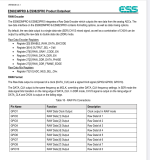A DSD modulator? And how is the PCM output made if the ADC is actually an oversampled 5-bit sigma-delta ADC?...made from PCM and what?
-
The Vendor's Bazaar forum is for commercial offers and transactions. Only unmoderated members can post here.
diyAudio provides this forum for the convenience of our members, but makes no warranty nor assumes any responsibility. We do not vet any members. Use of this facility is at your own risk. Customers can post any issues in those threads as long as it is done in a civil manner. All diyAudio rules about conduct apply and will be enforced.
